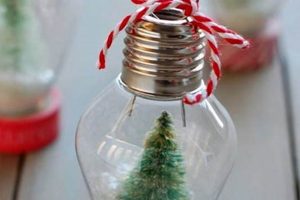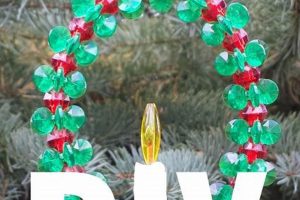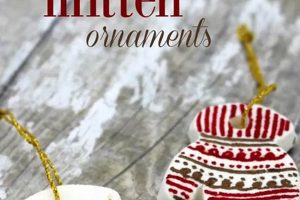Creation of a commemorative holiday decoration, personalized and handcrafted, marking an infant’s inaugural Christmas season is a popular tradition. These festive keepsakes often involve simple materials and techniques, allowing individuals with varying crafting skills to produce a unique memento. For example, a common project includes imprinting a baby’s hand or footprint onto a salt dough ornament.
This activity serves several purposes beyond holiday adornment. It fosters a sense of familial connection and provides a tangible record of a child’s early development. Furthermore, the finished product becomes a cherished artifact, evoking nostalgic memories during subsequent holiday seasons. Historically, homemade Christmas decorations have represented a personalized alternative to mass-produced items, reflecting individual creativity and family values.
The following discussion will explore various design options, material considerations, and safety precautions relevant to producing these personalized festive items, ensuring a memorable and enjoyable crafting experience.
Tips for Creating a Baby’s First Christmas Ornament
The creation of a lasting memento requires careful planning and execution. The following tips provide guidance for successfully crafting a unique and cherished holiday keepsake.
Tip 1: Material Selection: Opt for non-toxic, child-safe materials. Consider using air-dry clay, felt, or unfinished wooden shapes. Ensure paints, glues, and embellishments are specifically labeled as non-toxic.
Tip 2: Planning and Design: Conceptualize the ornament’s design prior to commencing the project. Sketching a preliminary design aids in material estimation and ensures a cohesive aesthetic.
Tip 3: Handprint/Footprint Techniques: When capturing a hand or footprint, work quickly and efficiently. Practice on a separate surface first to refine the technique and minimize errors. Gentle but firm pressure yields the clearest impression.
Tip 4: Personalization: Incorporate personal details to enhance the ornament’s sentimental value. Include the baby’s name, birthdate, or a short meaningful message.
Tip 5: Durability Considerations: Protect the finished ornament with a sealant or varnish to ensure its longevity. Multiple thin coats are preferable to a single thick coat.
Tip 6: Hanging Mechanism: Securely attach a hanging loop or ribbon. Test the weight-bearing capacity of the chosen attachment method to prevent breakage.
Tip 7: Safety First: Supervise the infant closely throughout the crafting process. Keep small parts and potentially hazardous materials out of reach. Never leave a baby unattended near crafting supplies.
Adhering to these guidelines helps to create a memorable and safe experience, resulting in a beautifully crafted ornament that will be treasured for years to come.
The subsequent section will address various design ideas and aesthetic considerations to further enhance the ornament’s personalization and visual appeal.
1. Material Safety
Material safety is of paramount importance when crafting an ornament intended to commemorate a baby’s first Christmas. Direct contact between the infant and the ornament, either through handling or mouthing, presents potential health risks if inappropriate materials are utilized.
- Non-Toxic Paints and Finishes
Paints and finishes must be explicitly labeled as non-toxic. Lead-based paints, common in older art supplies, pose a significant poisoning hazard. Acrylic paints marketed for children typically meet safety standards, but confirmation via product labeling is crucial. Finishes, such as varnishes or sealants, should also be non-toxic and ideally water-based to minimize volatile organic compound (VOC) exposure. Even seemingly innocuous materials can contain harmful chemicals; therefore, due diligence in product selection is imperative. In the event of ingestion, immediate medical attention may be required.
- Phthalate-Free Plastics and Adhesives
If utilizing plastic components, ensure they are phthalate-free. Phthalates are plasticizers linked to endocrine disruption and developmental issues. Similarly, adhesives must be carefully chosen. Solvent-based glues emit harmful fumes and can cause skin irritation. Opt for water-based, non-toxic glue sticks or white school glue. Hot glue guns, while convenient, present burn risks and should be used with extreme caution, kept well out of the reach of children. Secure and durable adhesion prevents small parts from detaching and becoming choking hazards.
- Natural and Unprocessed Materials
Natural materials, such as wood, cotton, or wool, can be a safer alternative to synthetic options, provided they are unprocessed. Unfinished wood should be sanded smooth to eliminate splinters. Dyed cotton or wool should utilize natural, non-toxic dyes. Avoid materials treated with pesticides or chemical preservatives. Even natural materials can pose risks; for instance, small seeds or dried flowers can present a choking hazard if detached from the ornament.
- Choking Hazard Mitigation
Regardless of the material, consider the potential for small parts to detach and become choking hazards. Beads, buttons, sequins, and other embellishments should be securely affixed and of a size that cannot be easily swallowed by an infant. Regularly inspect the ornament for loose parts and make necessary repairs. A general rule is that any object small enough to fit through a toilet paper roll presents a choking risk to young children. Consideration must be given to the destructive power of teething as well, soft materials might be chewed and broken much easier than harder ones.
The selection of safe materials necessitates a comprehensive understanding of potential hazards and a commitment to diligent product research. Failure to prioritize safety can result in serious health consequences for the infant. While the creation of a personalized ornament is a meaningful gesture, the well-being of the child must remain the foremost consideration. Using larger pieces is highly recommended to prevent detaching incidents.
2. Design Personalization
Design personalization represents a crucial aspect within the creation of a commemorative “baby’s first christmas ornament diy”. The capacity to tailor the ornament to reflect the infant’s unique identity and familial values elevates its significance beyond that of a mere decorative item. Conversely, a generic, unpersonalized ornament lacks the inherent sentimental value and connection to the specific child and family it is intended to represent. For example, incorporating the baby’s birth date, weight, and length at birth transforms a simple ornament into a tangible record of a specific moment in time.
Further personalization can involve utilizing colors associated with the baby’s nursery, incorporating fabrics from a meaningful garment, or including a small, symbolic object representing a family tradition. The effect of this personalization is a strengthened emotional bond between the ornament and its recipients. Moreover, personalized designs often stimulate conversation and evoke cherished memories during subsequent holiday seasons. Consider the practical application of embossing the baby’s footprint onto a clay ornament, adding a visual and tactile element that captures a fleeting stage of development. The understanding of these design principles allows for the creation of a more meaningful and appreciated keepsake.
In summary, design personalization is not merely an aesthetic consideration but a fundamental element in transforming a “baby’s first christmas ornament diy” into a cherished heirloom. The challenges lie in effectively incorporating personal details while maintaining visual harmony and long-term durability. Embracing thoughtful and individualized design choices ensures the ornament’s enduring emotional resonance and its connection to the broader theme of commemorating significant life events.
3. Infant's Involvement
The role of the infant in the creation of a “baby’s first christmas ornament diy” requires careful consideration. While direct participation may be limited by the infant’s age and developmental stage, strategic incorporation of the infant’s presence can significantly enhance the ornament’s sentimental value.
- Footprint or Handprint Capture
Imprinting the infant’s foot or hand onto the ornament represents a tangible form of involvement. This often involves pressing the appendage into soft clay, paint, or other pliable materials. The resulting impression serves as a lasting record of the infant’s physical size at a specific point in time. Practical challenges include ensuring the infant’s comfort and safety during the process and obtaining a clear, well-defined impression. For instance, using non-toxic, fast-drying paint minimizes mess and reduces the risk of accidental ingestion.
- Photographic Integration
Incorporating a photograph of the infant into the ornament provides a visual representation of their appearance during their first Christmas. This may involve transferring a photograph onto a wooden surface, embedding it within resin, or creating a photo-filled locket. The photograph serves as a direct visual link to the infant, allowing for immediate recognition and remembrance. Digital manipulation of the photograph, such as adding festive borders or text, further enhances its thematic relevance. The long-term preservation of the photograph, protecting it from fading or damage, requires attention to archival quality materials and techniques.
- Material Selection Based on Sensory Experience
Selecting materials that offer unique sensory experiences for the infant, such as soft fabrics or textured surfaces, can subtly engage the infant’s senses. While the infant may not actively participate in the ornament’s construction, the resulting texture or feel may be incorporated with intent and remembrance. A small swatch of the baby’s first blanket, carefully integrated into the ornament design, would serve as a tactile reminder of the infant’s early experiences.
- Proxy Participation Through Parental Representation
The act of the parents crafting the ornament on behalf of the infant can be viewed as a form of proxy participation. The parents’ love and care are infused into the creation process, imbuing the ornament with emotional significance. The selection of specific materials, colors, and designs reflects the parents’ understanding of the infant’s personality and their hopes for the infant’s future. This proxy involvement emphasizes the role of the family in shaping the infant’s early experiences and creating lasting memories.
These varied approaches to infant involvement, ranging from direct physical imprints to symbolic parental representation, underscore the multifaceted nature of the “baby’s first christmas ornament diy” tradition. Each method contributes uniquely to the ornament’s overall sentimental value and its capacity to evoke cherished memories in subsequent years.
4. Crafting Techniques
The successful creation of a “baby’s first christmas ornament diy” is intrinsically linked to the application of appropriate crafting techniques. Mastery of these techniques ensures both the aesthetic appeal and the long-term durability of the finished product. Inadequate execution undermines the ornament’s sentimental value and renders it susceptible to damage.
- Clay Molding and Shaping
Working with clay, whether air-dry or polymer, requires specific techniques to achieve desired forms. Proper kneading eliminates air pockets that can cause cracking during drying or baking. Consistent pressure ensures uniform thickness, preventing warping. The use of molds or stencils facilitates the creation of intricate designs. Improperly molded clay may exhibit structural weaknesses, leading to breakage. For instance, a poorly formed clay ornament may shatter if dropped, negating the effort invested in its creation.
- Fabric Cutting and Sewing
Employing fabric in ornament construction necessitates precise cutting and secure sewing. Accurate pattern tracing and clean cuts prevent fraying and maintain the intended shape. Hand-sewing techniques, such as the blanket stitch or whip stitch, provide durable seams. Machine sewing offers faster and more robust attachment, but requires careful handling of delicate fabrics. Haphazard cutting results in uneven edges, while weak stitching compromises the ornament’s structural integrity. Example, poorly sewn fabric is prone to ripping, while well-sewn will be durable and can be passed on to future generations.
- Adhesive Application and Bonding
Securely bonding disparate materials necessitates the correct application of appropriate adhesives. Surface preparation, including cleaning and sanding, enhances adhesion. Even distribution of adhesive prevents unsightly lumps and ensures uniform bonding. Clamping or weighting during the drying process maintains pressure and alignment. Insufficient adhesive application results in weak bonds, leading to detachment of components. For instance, a poorly glued decorative element may fall off, detracting from the ornament’s aesthetic appeal.
- Painting and Finishing
Achieving a professional-looking painted surface requires proper technique. Priming the surface enhances paint adhesion and provides a uniform base color. Multiple thin coats of paint, applied with smooth, even strokes, yield a consistent finish. Sealing the painted surface with varnish or lacquer protects against scratches and fading. Improper painting techniques, such as using thick, uneven coats, result in a textured, unprofessional appearance. Neglecting to seal the paint renders it vulnerable to damage, diminishing the ornament’s longevity.
The selection and implementation of appropriate crafting techniques are indispensable for the successful creation of a “baby’s first christmas ornament diy”. Proficiency in these techniques directly correlates with the ornament’s aesthetic quality, structural integrity, and overall sentimental value. Ultimately, careful attention to detail and skillful execution transform raw materials into a cherished keepsake.
5. Ornament Longevity
Ornament longevity holds significant relevance within the context of “baby’s first christmas ornament diy” projects. As keepsakes intended to commemorate a pivotal life event, these ornaments are often envisioned as enduring symbols, meant to be displayed and cherished for years to come. The capacity of an ornament to withstand the test of time directly impacts its ability to fulfill its intended purpose as a tangible memory.
- Material Durability and Resistance to Degradation
The inherent properties of chosen materials dictate an ornament’s resistance to environmental factors such as humidity, temperature fluctuations, and ultraviolet radiation. Materials prone to cracking, fading, or disintegration compromise the ornament’s structural integrity and visual appeal over time. For example, using acid-free paper or archival-quality inks minimizes discoloration and deterioration, ensuring the ornament retains its original vibrancy. Choosing materials resistant to insect infestation or mold growth further enhances longevity. The long term costs from material degradation must be weighed against the immediate cost of materials.
- Construction Techniques and Joint Stability
Robust construction techniques and stable joints prevent structural failures that can lead to breakage or component separation. Securely fastened seams, reinforced joints, and durable adhesives contribute to an ornament’s ability to withstand handling and storage stresses. For example, employing dovetail joints in wooden ornaments provides superior strength and resistance to pulling forces. Improperly constructed ornaments are susceptible to premature wear and tear, diminishing their lifespan. Poor workmanship can also be a hazard, leading to the detaching of small parts.
- Protective Coatings and Sealants
Application of protective coatings and sealants shields the ornament from environmental damage and physical abrasion. These barriers safeguard against scratches, moisture intrusion, and ultraviolet degradation. For example, applying multiple layers of polyurethane varnish to a painted ornament creates a durable, water-resistant finish. Failure to adequately protect the ornament’s surface renders it vulnerable to damage, reducing its long-term aesthetic appeal. Sealants protect against damage by children as well.
- Storage Conditions and Handling Practices
Appropriate storage conditions and careful handling practices minimize the risk of physical damage and environmental exposure. Storing ornaments in acid-free containers, away from direct sunlight and temperature extremes, preserves their integrity. Gentle handling prevents accidental breakage or surface scratches. For example, wrapping delicate ornaments in tissue paper and storing them in a padded box prevents damage during transit and storage. Neglecting proper storage and handling practices accelerates the aging process and shortens the ornament’s lifespan. Improper storage techniques such as placing a heavy ornament over a fragile can result in the fragile ornaments breaking.
These interconnected elements of material durability, robust construction, protective coatings, and careful storage collectively determine the long-term viability of a “baby’s first christmas ornament diy”. By prioritizing these factors, creators can ensure that their commemorative ornaments endure as cherished family heirlooms, serving as lasting reminders of a significant milestone.
Frequently Asked Questions
This section addresses common inquiries related to the creation of “baby’s first christmas ornament diy,” providing concise and informative answers.
Question 1: What materials are considered safest for a “baby’s first christmas ornament diy” project?
Optimal materials include non-toxic paints and glues, phthalate-free plastics, and natural, unprocessed materials like wood or cotton. Ensure all materials are free of small, detachable parts that could pose a choking hazard.
Question 2: How can the infant be safely involved in the “baby’s first christmas ornament diy” process?
Safe involvement includes capturing a handprint or footprint using non-toxic materials or incorporating a photograph of the infant into the ornament design. Supervise the infant closely and prevent contact with potentially hazardous materials.
Question 3: What techniques ensure the durability of a “baby’s first christmas ornament diy”?
Employ robust construction techniques, such as secure stitching for fabric ornaments or proper clay molding to prevent cracking. Apply protective coatings like varnish or sealant to shield the ornament from environmental damage.
Question 4: How should a “baby’s first christmas ornament diy” be stored to maximize its longevity?
Store the ornament in an acid-free container, away from direct sunlight, temperature extremes, and humidity. Wrap delicate ornaments in tissue paper to prevent scratches and breakage.
Question 5: What are the primary considerations when personalizing a “baby’s first christmas ornament diy”?
Personalization should reflect the infant’s unique identity and family values. Consider incorporating the baby’s birth date, weight, and length, or utilizing colors and materials associated with the baby’s nursery.
Question 6: How can the risk of small parts detaching from a “baby’s first christmas ornament diy” be minimized?
Select embellishments that are too large to be swallowed or securely affix smaller parts using strong, non-toxic adhesives. Regularly inspect the ornament for loose components and make necessary repairs.
Key takeaways emphasize the importance of material safety, robust construction, and careful storage in ensuring the longevity of a “baby’s first christmas ornament diy”. These precautions safeguard the ornament’s enduring value as a cherished keepsake.
The subsequent section will explore creative design ideas and thematic inspirations for “baby’s first christmas ornament diy” projects.
Conclusion
This exploration of “baby’s first christmas ornament diy” has underscored the paramount importance of material safety, skillful crafting techniques, and thoughtful personalization. It emphasizes that a successful outcome hinges on a commitment to non-toxic components, robust construction methods, and designs that resonate with familial values.
Creating a “baby’s first christmas ornament diy” transcends mere holiday decoration; it forges a lasting link to a significant life event. By adhering to the principles outlined herein, individuals can create a treasured heirloom that evokes cherished memories for generations to come, solidifying its place as a meaningful tradition.







